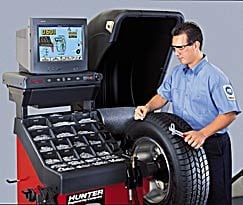How Does Tire Rack Confirm a Tire & Wheel Package Will Roll Smoothly?
(Lea en español)
Using the Hunter TC3500 mounting machine, optimal matching of the tire alignment relative to the wheel can be done with higher accuracy and help to eliminate vibration problems.

The Hunter GSP9700 Road Force measurement balancer road tests the mounted tire and wheel to effectively measure the uniformity of both and greatly reduce the amount of weights required to provide the smoothest possible ride.
Smooth-rolling tires and wheels can be the difference between having a vibration-free driving experience or a shaky one. If the tire and wheel tolerances are not examined, corrected, or are allowed to "stack up" rather than "cancel out" each other, the possibility of a balance or road force induced ride vibration exists. Because of this, our Tire & Wheel Packages don't ship unless they're Hunter-Balanced and Road Force® approved!
Tires are made up of internal beads, body plies and belts that are encased in rubber, assembled and cured. Alloy wheels are cast, cooled and machined. And even though they both are built to tight tolerances, there is bound to be some unavoidable weight imbalances during the manufacturing process.
When you consider that a typical passenger car tire mounted on an alloy wheel weighs about 40 pounds, it's amazing that the total amount of imbalance is typically no more than three to four ounces, or about one-half of one percent. So, if the tire and wheel combination isn't balanced with add-on weights, being off even an ounce or two can cause vibration at highway speeds. Heavier tire and wheel combinations, especially those used on light trucks, require more weights to maintain the same low percentage of imbalance.
In order to assure customer satisfaction, Tire & Wheel Packages are tested before shipment at no additional charge to our consumers using the Hunter Engineering GSP9700 Vibration Control System to evaluate and eliminate nearly all possible wheel- and tire-related vibration causes.
The GSP9700 Vibration Control System used to finish Tire & Wheel Packages goes far beyond the traditional capabilities of a wheel balancer. In addition to rectifying the inevitable wheel and tire imbalance, the GSP9700 Vibration Control System also "road tests" the mounted assembly to confirm virtually every aspect of a tire and wheel combination that might contribute to a vibration.
The GSP9700 Vibration Control System includes Hunter's exclusive Road Force Measurement System to help detect potential tire uniformity causes of vibration that are not balance-related. This system utilizes a "road roller" which applies up to 1,400 pounds (635 kg) of force against the wheel and tire assembly to measure their combined uniformity. This simulated road force test helps verify if the assembly is "round" when rolling under load.
The GSP9700 Vibration Control System can also measure lateral and radial rim runout (out of roundness or side-to-side movement) to identify and separate wheel runout from tire runout. The system then calculates the contributions of the wheel and the tire to a potential vibration and presents the service specialist with easy-to-follow instructions on the appropriate corrective actions.
If the wheel and tire are at the edge of acceptable tolerances, Hunter's patented ForceMatching(TM) feature is used to align the high point of the tire with the low spot of the rim. This helps maximize ride quality by minimizing the effects of tire force variation and rim runout. If a wheel or tire is found to be out of tolerance, it will be replaced with another wheel or tire that is within tolerance.
Once acceptable uniformity has been confirmed, or corrective actions have been completed, the technician can continue with precision wheel balance.
Hunter Engineering GSP9700 Specifications
Roller Force: up to 1,400 lbs. (635 kg)
Capacity:
- Rim Width: 1.5 in. (38mm) to 20 in. (508mm)
- Rim Diameter: 10 in. (254mm) to 24.5 in. (622.3mm)
- Maximum Tire Diameter: 40 in. (1016mm)
- Maximum Tire Width: 20 in. (508mm)
- Maximum Wheel and Tire Weight: 175 lbs. (80kg)
Radial and Lateral Runout Accuracy: .002 in. (0.05mm)
Radial Force Measurement Accuracy: 2 lbs., 10N (1.0 kg)
Imbalance Resolution: +/- 0.01 oz. or 0.5ms
Placement Accuracy: 512 positions, +/- .35°
